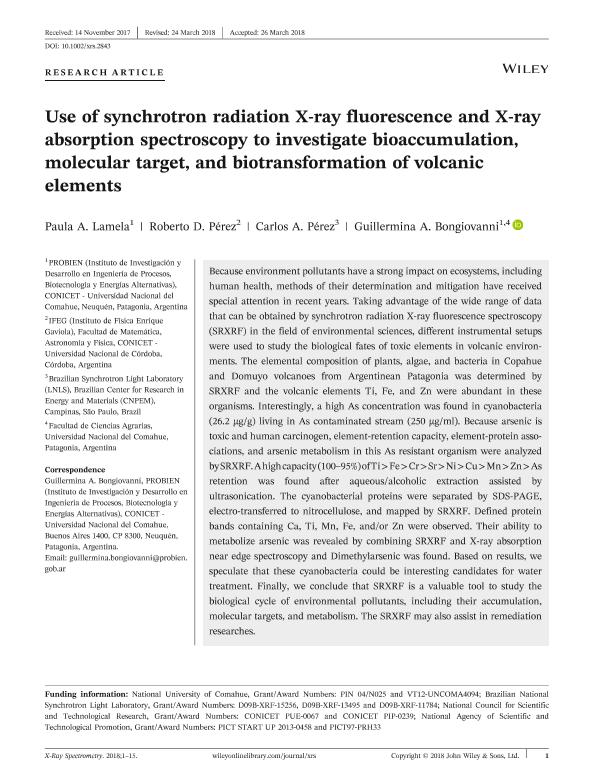Artículo
Use of synchrotron radiation X-ray fluorescence and X-ray absorption spectroscopy to investigate bioaccumulation, molecular target, and biotransformation of volcanic elements
Fecha de publicación:
07/2018
Editorial:
John Wiley & Sons Ltd
Revista:
X-ray Spectrometry
ISSN:
0049-8246
Idioma:
Inglés
Tipo de recurso:
Artículo publicado
Clasificación temática:
Resumen
Because environment pollutants have a strong impact on ecosystems, including human health, methods of their determination and mitigation have received special attention in recent years. Taking advantage of the wide range of data that can be obtained by synchrotron radiation X-ray fluorescence spectroscopy (SRXRF) in the field of environmental sciences, different instrumental setups were used to study the biological fates of toxic elements in volcanic environments. The elemental composition of plants, algae, and bacteria in Copahue and Domuyo volcanoes from Argentinean Patagonia was determined by SRXRF and the volcanic elements Ti, Fe, and Zn were abundant in these organisms. Interestingly, a high As concentration was found in cyanobacteria (26.2 μg/g) living in As contaminated stream (250 μg/ml). Because arsenic is toxic and human carcinogen, element-retention capacity, element-protein associations, and arsenic metabolism in this As resistant organism were analyzed by SRXRF. A high capacity (100–95%) of Ti > Fe > Cr > Sr > Ni > Cu > Mn > Zn > As retention was found after aqueous/alcoholic extraction assisted by ultrasonication. The cyanobacterial proteins were separated by SDS-PAGE, electro-transferred to nitrocellulose, and mapped by SRXRF. Defined protein bands containing Ca, Ti, Mn, Fe, and/or Zn were observed. Their ability to metabolize arsenic was revealed by combining SRXRF and X-ray absorption near edge spectroscopy and Dimethylarsenic was found. Based on results, we speculate that these cyanobacteria could be interesting candidates for water treatment. Finally, we conclude that SRXRF is a valuable tool to study the biological cycle of environmental pollutants, including their accumulation, molecular targets, and metabolism. The SRXRF may also assist in remediation researches.
Palabras clave:
SRXRF
,
BIOGEOCHEMISTRY
,
ARSENIC SPECIATION
,
BIOACCUMULATION
Archivos asociados
Licencia
Identificadores
Colecciones
Articulos(PROBIEN)
Articulos de INST. DE INVESTIGACION Y DES. EN ING. DE PROCESOS, BIOTECNOLOGIA Y ENERGIAS ALTERNATIVAS
Articulos de INST. DE INVESTIGACION Y DES. EN ING. DE PROCESOS, BIOTECNOLOGIA Y ENERGIAS ALTERNATIVAS
Citación
Lamela, Paula Andrea; Perez, Roberto Daniel; Pérez, Carlos A.; Bongiovanni, Guillermina Azucena; Use of synchrotron radiation X-ray fluorescence and X-ray absorption spectroscopy to investigate bioaccumulation, molecular target, and biotransformation of volcanic elements; John Wiley & Sons Ltd; X-ray Spectrometry; 47; 4; 7-2018; 305-319
Compartir
Altmétricas




